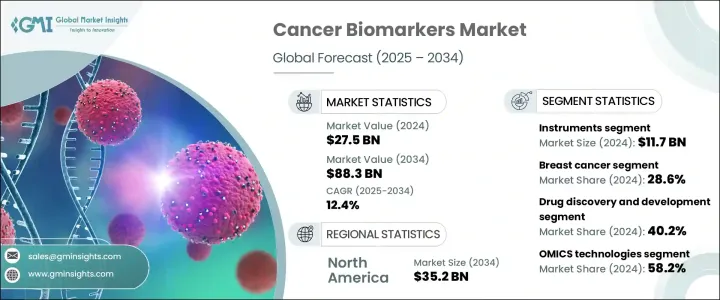
세계 암 바이오마커 시장은 2024년 275억 달러로 평가되었고, 2025-2034년 연평균 12.4%의 성장률을 보일 것으로 예측됩니다.
암 바이오마커는 혈액, 조직, 체액에 포함된 단백질, 유전자 및 다양한 분자로 구성되며, 현대 종양학에서 필수적인 도구가 되고 있습니다. 전 세계적으로 암 발병률이 급증하는 가운데, 이러한 바이오마커는 의료 전문가들이 다양한 형태의 암을 감지, 모니터링 및 치료하는 방식에 혁명을 일으키고 있습니다. 이러한 바이오마커는 암을 조기에 진단하고, 병의 진행을 평가하고, 맞춤형 치료를 조정하는 데 매우 중요한 역할을 하며, 궁극적으로 환자의 생존율과 삶의 질을 향상시킬 수 있습니다. 정밀의료와 표적치료가 점점 더 중요해지고, 의료시스템이 불필요한 치료를 줄이면서 진단 정확도를 높이기 위해 노력함에 따라 첨단 바이오마커 기술에 대한 수요가 더욱 증가하고 있습니다.

분자진단의 지속적인 연구와 기술 혁신으로 바이오마커의 범위가 확대되고 있으며, 임상시험, 의약품 개발, 치료 모니터링에 필수적인 요소로 자리 잡고 있습니다. 암은 전 세계적으로 주요 사망 원인 중 하나이기 때문에 바이오마커를 일상적인 임상에 도입하려는 움직임이 증가하고 있습니다. 바이오마커는 증상이 나타나기 전에 암을 식별하여 조기 개입과 더 나은 치료 결과를 가능하게 한다는 점에서 매우 유망합니다. 또한, 액체 생검, 유전체 분석, 단백질체학의 지속적인 개선으로 암 바이오마커의 잠재적 용도가 확대되고 있으며, 비침습적이고 정밀한 암 검출 솔루션의 새로운 길을 열어가고 있습니다.
| 시장 범위 | |
|---|---|
| 시작 연도 | 2024년 |
| 예측 연도 | 2025-2034년 |
| 시작 금액 | 275억 달러 |
| 예상 금액 | 883억 달러 |
| CAGR | 12.4% |
암 바이오마커 검출 시장의 기기 분야는 2024년 117억 달러 규모에 달했고, 2025년부터 2034년까지 연평균 12.3%의 성장률을 보일 것으로 예측됩니다. 중합효소연쇄반응(PCR) 장비, 차세대 염기서열분석(NGS) 플랫폼, 질량분석기 등 첨단 진단 도구가 암 바이오마커 연구의 최전선에 있습니다. 이들 장비는 암과 관련된 유전자 돌연변이 및 분자 시그니처를 검출하는 데 있어 독보적인 민감도와 정확도를 제공합니다. 또한, 한 번의 검사로 여러 바이오마커를 동시에 분석할 수 있는 멀티플렉싱을 지원하여 효율성과 비용 효율성이 크게 향상되었습니다. 이러한 첨단 기술이 통합된 이 장비는 진단의 신속성, 신뢰성, 범용성, 그리고 확장되는 암 바이오마커 시장에 필수적인 요소로 자리매김하고 있습니다.
시장은 유방암, 전립선암, 대장암, 자궁경부암, 간암, 폐암 등 암의 유형에 따라 분류됩니다. 유방암 분야는 2024년 28.6%로 압도적인 점유율을 차지했고, 2034년에는 259억 달러에 달할 것으로 예상되며, CA15-3이나 CA27-29와 같은 검사는 기존 영상진단법과 병행하여 진단 정확도를 향상시키는 중요한 도구가 될 수 있습니다. 전 세계적으로 유방암 발병률이 지속적으로 증가하고 있으며, 조기 검진에 대한 인식이 높아지면서 이 부문의 성장에 크게 기여하고 있습니다.
미국 암 바이오마커 시장은 2023년 92억 달러 규모 시장을 창출했으며, 세계 최고의 지역 시장으로 자리매김하고 있습니다. 미국 전역의 암 발병률 증가와 바이오마커 기반 진단 솔루션의 발전이 결합하여 시장의 견조한 성장을 견인하고 있습니다. 조기 발견과 맞춤 의료에 대한 수요가 증가하면서 미국은 암 바이오마커 연구와 기술 혁신의 중요한 거점이 되고 있습니다.
The Global Cancer Biomarkers Market was valued at USD 27.5 billion in 2024 and is projected to grow at a CAGR of 12.4% between 2025 and 2034. Cancer biomarkers, which comprise proteins, genes, and various molecules found in blood, tissues, and bodily fluids, are becoming essential tools in modern oncology. As cancer prevalence continues to surge worldwide, these biomarkers are revolutionizing the way healthcare professionals detect, monitor, and treat different forms of cancer. They play a pivotal role in diagnosing cancer at an early stage, evaluating disease progression, and tailoring personalized therapies, ultimately enhancing patient survival rates and quality of life. The growing emphasis on precision medicine and targeted therapies is further driving demand for advanced biomarker technologies, as healthcare systems strive to improve diagnostic accuracy while reducing unnecessary treatments.

Ongoing research and innovation in molecular diagnostics are also expanding the scope of biomarkers, making them indispensable in clinical trials, drug development, and treatment monitoring. With cancer being one of the leading causes of death globally, the integration of biomarkers into routine clinical practice is gaining momentum, as they hold immense promise in identifying cancer even before symptoms arise, thereby enabling early interventions and better outcomes. Moreover, the continuous improvements in liquid biopsy, genomic analysis, and proteomics are broadening the potential applications of cancer biomarkers, offering new avenues for non-invasive and highly accurate cancer detection solutions.
| Market Scope | |
|---|---|
| Start Year | 2024 |
| Forecast Year | 2025-2034 |
| Start Value | $27.5 Billion |
| Forecast Value | $88.3 Billion |
| CAGR | 12.4% |
The instruments segment in the cancer biomarker detection market generated USD 11.7 billion in 2024 and is anticipated to grow at a CAGR of 12.3% from 2025 to 2034. Advanced diagnostic tools such as polymerase chain reaction (PCR) machines, next-generation sequencing (NGS) platforms, and mass spectrometers are at the forefront of cancer biomarker research. These instruments offer unmatched sensitivity and precision in detecting genetic mutations and molecular signatures associated with cancer. They also support multiplexing, which allows simultaneous analysis of multiple biomarkers in a single test, significantly improving efficiency and cost-effectiveness. The integration of cutting-edge technologies in these instruments ensures faster diagnosis, enhanced reliability, and broader accessibility, making them critical to the expanding cancer biomarkers landscape.
The market is segmented based on cancer types, including breast, prostate, colorectal, cervical, liver, and lung cancers. The breast cancer segment accounted for a dominant share of 28.6% in 2024 and is forecasted to reach USD 25.9 billion by 2034. Biomarkers are fundamental in detecting breast cancer at an early stage, with tests like CA 15-3 and CA 27-29 serving as important tools to improve diagnostic precision when used alongside traditional imaging methods. The continuously rising incidence of breast cancer globally and increasing awareness about early screening methods are key contributors to the growth of this segment.
The U.S. Cancer Biomarkers Market generated USD 9.2 billion in 2023, positioning itself as one of the leading regional markets worldwide. The surging cancer rates across the country, combined with advancements in biomarker-based diagnostic solutions, are driving robust market growth. Increasing demand for early detection and personalized medicine continues to make the U.S. a significant hub for cancer biomarker research and innovation.